Ceramic mugs make up a large part of the utensils we use. Why do many people choose ceramic materials? The reason is that ceramics have many advantages over other materials: plasticity is very strong (single shape), porcelain surface is smooth and easy to clean, materials are high-temperature baking, non-toxic and harmless (some are easy to be healthy), etc., which make ceramics popular with the public. Is it not curious to introduce how such a good ceramic mug will be produced?
First, let’s understand how the ceramic mug transforms from clay to cup:
1. Practice the mud: Take the porcelain stone from the mining area, finely pour the water, wash it, remove the impurities, and precipitate into a brick-like mud. Then mix the mud with water, remove the slag, rub it with your hands, or step on it with your feet, squeeze out the air in the mud, and make the water in the mud even.
2, drawing: the mud group thrown in the center of the carousel of the car, with the flexion and extension of the method of drawing and drawing the general appearance of the body.
3. Ink blank: The shape of the stamp is to be rotated according to the inner arc of the blank. The blank which is dried to the semi-dry is placed on the mold, and the outer wall of the blank is evenly pressed, and then demolded.
Billet: The billet is placed on the profitable bucket of the brake, the disc is rotated, and the cutter is used for turning. The thickness of the blank is appropriate and the surface is smooth. This is a highly technical process.
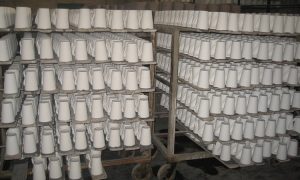
4. Drying the blank: Place the processed blank on the wooden frame to dry it.
5, engraved: use bamboo, bone or iron cutter to paint the pattern on the dried or semi-dry body.
6. Glazing: Ordinary round mouth is made of enamel glaze (immersing the slab into the glaze basin, when the mouth is flush with the glaze), or glazing (the glaze is poured into the slab to sway, so that the upper and lower sides are evenly glazed, then quickly Pour off excess glaze), 琢 (relative to the “rounder”, “rounder” refers to a circular vessel shaped by a blanking method, such as a bowl, a plate, a dish, etc., and a more complicated forming process, Such as bottles, statues, pots, cans, etc., it is called “scrub”, or large rounds are blown with glaze (the method is to blind the bamboo tube with a spun yarn, and then spray the nozzle with the enamel, so repeatedly, the thickness of the blank can be obtained. Uniform glaze).
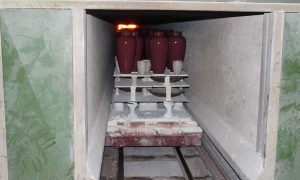
7. Kiln: The time course is about one night and the temperature is around 1300 °C. Firstly, the kiln door is fired, the kiln is ignited, the fuel is Songchai, the technical guidance of the pilework is taken, the fire is measured, the temperature of the kiln is changed, and the time of the ceasefire is determined.
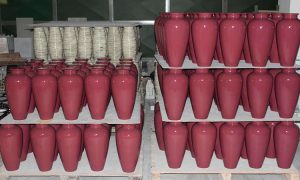
8, color glaze: glaze color such as multicolored, pastel, etc., is painted on the glazed surface of the burnt porcelain, fill the color, and then into the red furnace to burn at low temperature, the temperature is about 700 ° C – 800 ° C. In addition, before the kiln is painted on the green body, such as blue and white, glazed red, etc., it is called glaze red, which is characterized by the color under the high temperature glaze, never fade.
To complete a mug and go through 9 steps, the finished product that appears in front of us always feels something missing. What’s less is the LOGO and pattern we want to print, which is the most distinguishing feature of the other mugs. Now the process is divided into four types for customization: silk screen, roasted flowers, sublimation, engraving
Silk screen:
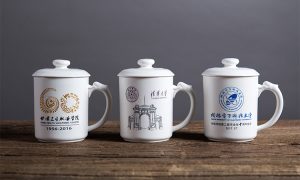
At present, there are fewer screen printing processes on ceramic materials. The effect of silk screen printing is similar to that of roasted flowers, but there is a slight deficiency. The use of printing for a period of time is easy to fall and the pattern is not completely missing. If it is not a tight schedule or a limited budget, we recommend baking or sublimation printing.
Roasted flowers:
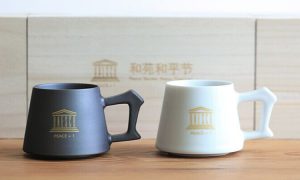
Common name: decal paper
The popular point is that the flower paper is a very thin film, and the pattern on the film is printed on the film. This is the printing paper process and the premise of the mug baking flower.
Paste the finished flower paper on the mug. It is required that the flower paper should be very flat and completely attached to the top of the mug. There should be no air bubbles in the middle, and the printed part should not have wrinkles. Otherwise, the mug is prone to bursting when the flower is baked at high temperature (that is, the printed part is spent). The situation). Some decals should be hand-applied by the applique workers. This is why the ten identical patterns of the mugs we can see are placed in a row, and the printed patterns are not in a straight line.
Place the paper-stuffed mug in the kiln and bake it at high temperature. The key to baking flowers is temperature. The temperature is limited by the color of the paper and the material of the ceramic mug. That is to say, different colors need to be baked at different temperatures in order to make a better product. If the temperature is lower than the temperature required by the color, the printed pattern is not glossy, and the color is not bright. If the temperature is higher than the temperature required by the color, the printed pattern will become pale and white, even if it is not printed. However, the material of the ceramic mug also affects the temperature of the roasted flower, because the temperature of the roasted flower is just enough to melt the glaze on the ceramic mug. At this time, the ceramic toner on the flower paper will penetrate into the glaze, and wait until After the product is cooled down, the color and the ceramic mug are integrated, so that the ceramic mug does not fade. If the temperature of the roasted flower is too low, the glaze of the ceramic mug has not yet begun to change and the baking has been completed. Then the printed color is only attached to the surface of the ceramic mug, and if the pattern is wiped with a wet towel, it will fall off.
We are Sublimation Mug Manufacturer
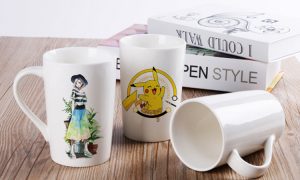
Sublimation transfer is to image the portrait, landscape, text and other images by using an inkjet printer equipped with sublimation transfer ink on the inkjet paper for sublimation transfer, and then heated to the thermal transfer device. At about 200 °C, the thermal transfer ink on the sublimation paper is sublimated into the substrate, thereby faithfully transferring the color image on the paper to a material such as textile, porcelain mug, porcelain plate, porcelain plate, metal, etc. A new process.
Sculpture:

Laser is the product of high-tech in the 21st century. Laser engraving can also be applied to ceramic engraving. Moreover, modern laser engraving technology adopts numerical control and professional software matching methods. As long as the pattern is designed, the rest will be All are handed over to the laser machine to complete, laser engraving wants to be traditional engraving techniques, laser engraving has the characteristics of fast engraving speed, engraving pattern, suitable for mass production.

